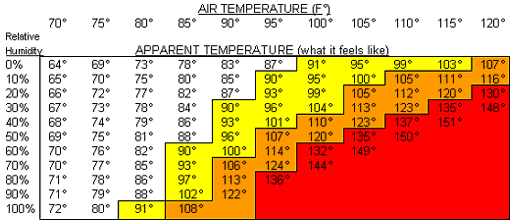"Runnning in the Heat; Respect Your Body, Respect the Heat"
by Mindy Solkin
HEAT INDEX CHART

Apparent
Temperature |
Heat Stress Risk with Physical Activity
and/or Prolonged Exposure |
| 90° - 105° |
Heat cramps or heat exhaustion possible |
| 105° - 130° |
Heat cramps or heat exhaustion likely
Heatstroke possible |
| 130°+ |
Heatstroke highly likely |
Of all the adversities that runners and marathoners face, heat is the number one offender. This is because it can bring on two conditions that can negatively affect your performance… Overheating and Dehydration.
Overheating is the result of inadequate cooling; when the body cannot keep up with the demands of evaporation of water from your skin. When the body heats up internally, it starts to sweat and sends more blood to the skin where it is cooled by coming into contact with the relatively cooler skin. However, while running, your body's demand for oxygen to the muscles means less blood will flow to the skin and this is when overheating occurs. And thus begins the tug-of-war within your body, especially if you want to keep up a certain pace. Either the blood (and oxygen) goes to your muscles to keep up with the pace demands and you start to overheat because less blood is going to the skin for cooling - OR - the blood goes to the skin for cooling, but less blood goes to your working muscles meaning you'll be forced slow down.
Dehydration is the process of losing fluid from the body, in this case through sweat. As you sweat you lose water and electrolytes. That's why drinking a sports drink containing electrolytes, as well as water, is so important. Because running in the heat exacerbates both overheating and dehydration, it is important to take precautions when running in the heat.
PRECAUTIONS FOR RUNNING IN THE HEAT
1) It takes approximately two weeks of consistent running in the heat and humidity to acclimate to warmer conditions.
2) Remember that thirst is not an indicator of dehydration. Once you are thirsty, you are already low on fluids. Indications of dehydration are an elevated heart rate during and after your run and dark, golden-colored urine. After your run, keep drinking fluids until your urine is clear.
3) During your run, drink about 4 to 8 ounces of water and/or sports drink every 15 to 20 minutes.
4) Weigh yourself before and after your run. Drink 16 ounces of fluid for every pound of weight lost. *Important note here... do not use this as a method of weight loss!
5) Apply a sunscreen of at least SPF #15. Make sure that it is a non-drip formula that won't drip into your eyes.
6) Wear sunglasses that filter UVA and UVB rays and/or wear a cap with a visor.
7) Wear light-colored micro-fiber clothing.
8) Run when your shadow is taller than you are, and when the sun is not high in the sky. If you run in the morning, you'll avoid the heat, but may encounter a higher humidity. The air quality is also better in the morning, since ozone levels increase soon after dawn, peak at midday, and then again in the early evening. Times to avoid running are noon till 3pm.
9) Eat salty foods and drinks such as pretzels and tomato juice.
10) Check the Heat Index Chart for apparent temperature. This is the number that calculates the air temperature with the relative humidity to determine what the temperature feels like and if there is a risk of a heat-related illness.
SIGNS OF HEAT-RELATED ILLNESS
1) HEAT CRAMPS
Causes: Loss of electrolytes and accumulation of lactic acid in the muscles.
Conditions: Muscle cramps and/or spasms, heavy sweating, normal body temperature.
Treatment: Drink water and sports drink, slow down, massage affected area.
2) HEAT EXHAUSTION
Causes: Intense exercise in a hot, humid condition and loss of electrolytes.
Conditions: Profuse sweating, possible drop in blood pressure (less than 90
systolic, the top number), normal or slightly elevated body temperature, lightheadedness, nausea, vomiting, decreased coordination, possible fainting.
Treatment: Rest in a cool place, drink water and sports drink, if BP drops below 90 systolic, call EMS, avoid activity for at least 24 hours, refrain from running or exercising in the heat for at least one week.
3) HEAT STROKE
This is a medical emergency!
Causes: Intense exercise in a hot, humid condition, older age, dehydration, obesity, wearing heavy clothing, running in the heat when you have an infection or fever, certain drugs such as amphetamines, diuretics, beta blockers, cardiovascular disease, poor acclimatization, high blood pressure.
Conditions: High body temperature (106 or higher), lack of sweating characterized by dry, red skin, altered consciousness.
Treatment: Call EMS! Rest in a cool place, remove clothing to expose skin to air, apply ice packs or cool water to groin, underarms, neck (stop if shivering).
| 




